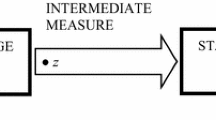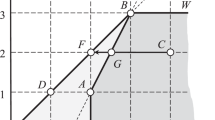Abstract
Molinero and Tsai (1997) proposed a data envelopment analysis (DEA) model to evaluate a production entity that is characterized by shared inputs and shared outputs. They claimed that their proposed model has a convex solution space, and thus a convex program. This conclusion, if it were correct, should be applicable potentially not only to the model given by the authors, but also arguably to all the researches concerning shared inputs and/or shared outputs in the literature. Because of its potential influence, we show that the conclusion is not correct and the significance of the incorrectness without reducing the interestingness of their work, as the establishment of Kuhn-Tucker condition is interesting by itself.

Similar content being viewed by others
References
Banker RD, Charnes A and Cooper WW (1984). Some models for estimating technical and scale inefficiencies in data envelopment analysis. Management Science 30 (9): 1078–1092.
Beasley JE (1995). Determining teaching and research efficiencies. Journal of the Operational Research Society 46 (4): 441–452.
Charnes A, Cooper WW and Rhodes E (1978). Measuring the efficiency of decision making units. European Journal of Operational Research 2 (6): 429–444.
Cherchye L, De Rock B, Dierynck B, Roodhooft F and Sabbe J (2013). Opening the ‘black box’of efficiency measurement: Input allocation in multi-output settings. Operations Research 41 (5): 1148–1165.
Imanirad R, Cook WD and Zhu J (2013). Partial input to output impacts in DEA: Production considerations and resource sharing among business subunits. Naval Research Logistics 60 (3): 190–207.
Molinero CM (1996). On the joint determination of efficiencies in a data envelopment analysis context. Journal of the Operational Research Society 47 (10): 1273–1279.
Molinero CM and Tsai PF (1997). Some mathematical properties of a DEA model for the joint determination of efficiencies. Journal of the Operational Research Society 48 (1): 51–56.
Acknowledgements
The authors are grateful for the comments and suggestions of the two anonymous reviewers. This research is supported by National Natural Science Funds of China (No. 71301155, 71301037), National Natural Science Funds of China for Innovative Research Groups (No. 71121061) and the Fundamental Research Funds for the Central Universities (J2014hgbz0172).
Author information
Authors and Affiliations
Rights and permissions
About this article
Cite this article
Ding, J., Zhang, P. & Feng, C. Comment on some mathematical properties of a DEA model for the joint determination of efficiencies. J Oper Res Soc 66, 1960–1966 (2015). https://doi.org/10.1057/jors.2015.15
Received:
Accepted:
Published:
Issue Date:
DOI: https://doi.org/10.1057/jors.2015.15




